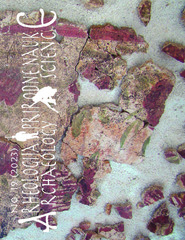Приказ основних података о документу
First Half of the FLOW Project - Methods, Practices and First Results
| dc.creator | Gajić-Kvaščev, Maja | |
| dc.creator | Ljuština, Marija | |
| dc.creator | Filipović, Vojislav | |
| dc.creator | Mladenović, Ognjen | |
| dc.creator | Bulatović, Aleksandar | |
| dc.creator | Kapuran, Aleksandar | |
| dc.creator | Milojević, Petar | |
| dc.creator | Milić, Bogdana | |
| dc.date.accessioned | 2024-01-12T11:41:05Z | |
| dc.date.available | 2024-01-12T11:41:05Z | |
| dc.date.issued | 2023 | |
| dc.identifier.issn | 1452-7448 | |
| dc.identifier.issn | 2738-1102 | |
| dc.identifier.uri | http://rai.ai.ac.rs/handle/123456789/1426 | |
| dc.description.abstract | The paper summarises the results achieved during the first 18 months of the project THE FLOW (Interactions-Transmission-Transformation: Long-distance connections in Copper and Bronze Age of the Central Balkans). The project team has visited 12 museums in the territory of Central Serbia and accumulated a total of 5,000 km of road trips. More than 400 pottery samples from 67 archaeological sites were collected for provenance analyses, thermoluminescence and optically stimulated luminescence dating. Samples have also been collected from more than 150 bronze and 64 copper artifacts, as well as more than 25 samples from clay pits and ore deposits. A total of 30 samples from obsidian artifacts have been collected. Following the collection of samples, procurement procedures were conducted for AMS and TL/OSL dating, as well as calls for isotopic analyses of copper and tin provenance. Contracts for TL/OSL analyses have been signed with Instituto Universitario de Geología “Isidro Parga Pondal” from La Coruña (Spain), and for AMS analyses with Isotoptech Zrt. from Debrecen (Hungary), and Rutgers University in New Jersey (USA). Laboratory research within the project has so far brought many important results, among which are those on the origin of the raw materials for making the analysed ceramic vessels, as well as the pigments used for their decoration. Extremely significant data was obtained on the composition of the analysed items made of metal - weapons and jewellery, on the basis of which preliminary conclusions were made about the technology of their production, and them belonging to a certain region or workshop. The project initiated the creation of a network of scientific collaborations that can be continued through future joint projects and applications on international calls. The following project activities will be aimed towards the consolidation of already established methodological procedures as well as the interpretation of the awaited outcomes and their integration into explanatory models of complex processes in the societies in later prehistory. | sr |
| dc.language.iso | en | sr |
| dc.publisher | Beograd: Arheološki institut | sr |
| dc.publisher | Beograd: Centar za nove tehnologije Viminacium | sr |
| dc.relation | info:eu-repo/grantAgreement/ScienceFundRS/Ideje/7750074/RS// | sr |
| dc.rights | openAccess | sr |
| dc.rights.uri | https://creativecommons.org/licenses/by-nc-nd/4.0/ | |
| dc.source | Arheologija i prirodne nauke | sr |
| dc.subject | Pottery | sr |
| dc.subject | Copper | sr |
| dc.subject | Bronze | sr |
| dc.subject | Obsidian | sr |
| dc.subject | Provenance studies | sr |
| dc.subject | Isotopic analyses | sr |
| dc.subject | Absolute dating | sr |
| dc.subject | Long distance connections | sr |
| dc.title | First Half of the FLOW Project - Methods, Practices and First Results | sr |
| dc.type | article | sr |
| dc.rights.license | BY-NC-ND | sr |
| dc.citation.epage | 185 | |
| dc.citation.issue | 19 | |
| dc.citation.spage | 173 | |
| dc.identifier.doi | 10.18485/arhe_apn.2023.19.11 | |
| dc.identifier.fulltext | http://rai.ai.ac.rs/bitstream/id/4158/First_half_of_the_FLOW_project_methods_p.pdf | |
| dc.type.version | publishedVersion | sr |


